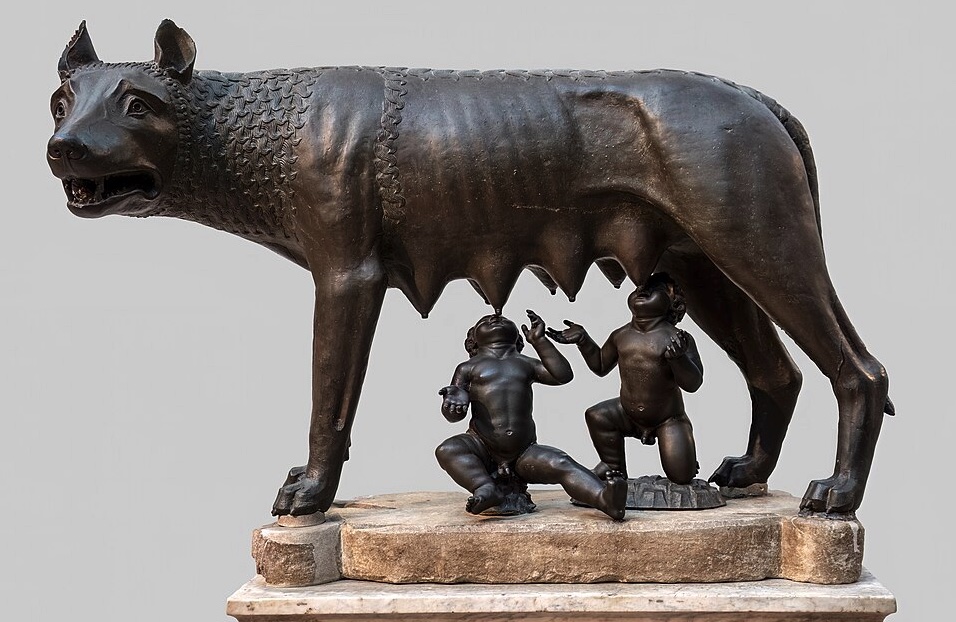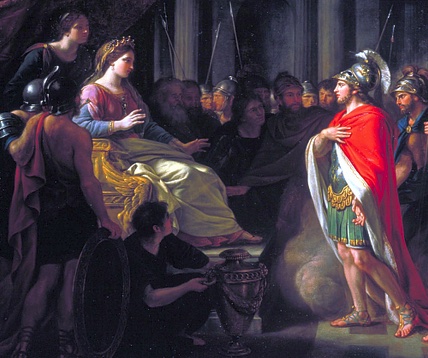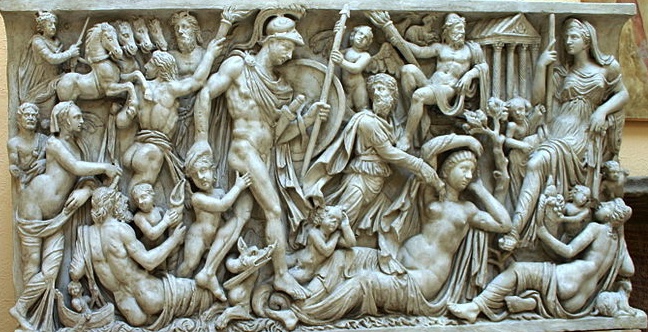
- Articles, Recent
Ancient Rome, Founded in Myth and Legend by Miguel A. Faria, MD
The founding of Rome is in the realm of myth and legend as well as history. Rome’s historic past was obscured by the mist of time, and so when the Romans reached their apogee, and Rome had become the greatest and most powerful city in the world, Roman historians felt that her fantastic achievement in the Mediterranean world and beyond was worthy of a glorious and heroic past. The Romans were aware of such Greek epic poetry as the Iliad and the Odyssey, as well as other mythological Hellenic literature in addition to works of history and philosophy. The Romans admired Greek civilization, which by the time of the heyday of the Romans had waned, and the Greek city-states were no threat to Rome. And so, Roman poets and historians weaved a tale where a little history and a lot of myth became inextricably intertwined in formulating the early history of Rome.
The Trojan war, which was recounted in parts of the Greek Homer’s Iliad and the Odyssey, became the initial centerpiece of the legendary tale. In this light, the great Roman poet Virgil wrote the long epic poem, the Aeneid, while the historian Livy (59 BC-AD 17) wrote a majestic series of books on the history of Rome in eloquent prose that recounted the chronicles of early Rome up to his own time. Fortunately, many of his books have survived, including those on early Rome—Ab Urbe Condita “From the Founding of the City” (753 BC).
The Trojan War and the Voyage of Aeneas
From the mist of history and legend aroused the mighty mercantile city of Troy where gods and men fought for supremacy of the city’s commerce and wealth, and the possession of the most beautiful woman in the world, Helen, the wife of Menelaus, king of Sparta. Helen was so beautiful that she “launched a thousand ships” and became Helen of Troy–taken there by the artful seduction of Paris, Prince of Troy, the son of Priam and Hecuba, King and Queen of Troy. The thousand ships were loaded with mythic warriors that included Agamemnon, King of Mycenae, Achilles, Ulysses, and dozens of Greek heroes created by the equally mythic blind poet Homer. These sailing warriors were assisted by the goddesses Hera and Athena and the gods Hermes (Mercury) and Poseidon (Neptune); whereas Aphrodite (Venus), Apollo, and Ares (Mars, the god of war) supported the Trojans. After ten years the city was taken by the subterfuge of Greeks bearing a gift: the Trojan Horse. And so, the once-impregnable city Troy was taken.

After the Greeks had sacked Troy at about 1200 BC, Aeneas, a prince and one of the greatest of Trojan heroes, escaped from the doomed and burning city with a band of followers. They sailed away in twenty ships in search of land where they could build a new city. The Aeneid traces the saga of the indomitable Aeneas and his band of compatriot through strange lands and seas. After numerous travails and adventures, Aeneas and his Trojan companions landed in North Africa near the city of Carthage, which had been founded by the Phoenicians and where now Queen Dido ruled the land. She fell in love with the intrepid Aeneas, a strong and handsome descendent of Aphrodite. Dido pleaded that he stay and rule Carthage with her. But Jupiter decided otherwise and sent Mercury, the messenger god, to tell Aeneas that he had to leave and fulfill his destiny. He hastily departed, and Dido, deserted and broken hearted, slayed herself with a sword. And here, we can suppose, the seed of future enmity between Carthage and Rome was planted.
Aeneas and his indomitable companions made it to the southwest coast of Italy, where king Latinus ruled. It was this mythologic king who supposedly gave the name Latin and Latium to the language, the people, and the region. Aeneas was well received by the king and because he had lost his wife Creusa during the sack of Troy, he married the king’s daughter, the beautiful Lavinia. Aeneas ruled Latium after the king died, and a generation later his son Ascanius (also known as Iulus or Julius), who had accompanied him from Troy, founded nearby the city of Alba Longa. Thus, many generations later, Julius Caesar and his Julian family clan claimed their old patrician lineage and descent from Aphrodite.
Rhea Sylvia, the Twins, and the She-Wolf
In any event, the descendants of Ascanius, formed a long line of kings in the Latin city of Alba Longa. According to this mythology, both Romulus and Remus were descended from Aeneas through their mother Rhea Silvia. This maiden was the daughter of the king of Alba Longa, Numitor, and thus descended from Aeneas and Ascanius. According to Livy, Numitor’s younger brother Amulius killed the king and seized the throne. And to prevent Rhea Sylvia from having children that would challenge his rule, Amulius forced her to become a Vestal virgin, a sacred priestess of the goddess Vesta, who were sworn to celibacy. However, Rhea Sylvia became pregnant with twins when she was raped by Mars the god of war while she had gone to a grove to fetch water for the temple.

Amulius learned of the birth of the twins and ordered they be killed, but the servant who had been so commanded instead showed compassion and set them adrift in a basket at the bank by the Tiber river. They drifted and landed near the Palatine hill where they were saved by a she-wolf who suckled them. Later Rhea Sylvia died by throwing herself in the river. The baby boys, abandoned in the wilderness, were brought up by the she-wolf that suckled them and nurtured them to health during their vulnerable infancy. The twins grew up and overthrew the usurper Amulius and reinstated Numitor as king in 752 BC. Romulus and Remus then decided they would build a new city: The City of the Seven Hills, or the Eternal City.
Romulus, Remus, and the Founding of Rome
Most textbooks give 753 BC as the traditional date for the founding of Rome (Ab Urbe Condita ) by the mythologic twins, Romulus and Remus. Unfortunately, the boys quarreled and Romulus (after which Rome is named) killed Remus. They quarreled upon arriving at the seven hills. Romulus wanted to build Rome at the Palatine Hill; Remus, at the Aventine Hill. They resorted to augury. Remus saw six auspicious birds, but Romulus saw twelve and claimed divine favor. A dispute followed in which Remus was killed. A story relates that Remus jumped over the furrow that Romulus was ploughing around the Palatine Hill demarcating the city wall of Rome, mocking his brother’s effort. Remus insulted Romulus about the inadequacy of the city “wall” against invaders. In anger Romulus (or one of his followers) struck Remus and killed him.
The story, imbued with the usual philosophic duality of myth and prophecy of antiquity, presaged that as punishment for the sacrilegious act of fratricide, nascent Rome built upon the Palatine Hill, would grow and prosper to become a mighty and dazzling city that, in due time, would rule an impressive and glorious empire—but as atonement for the unspeakable crime, the power of Rome would only last a thousand years. The unforgivable sin of fratricide would ultimately bring down the City Upon the Hill, which otherwise had been destined for glory.
And so, the Romans, despite their great conquests, became and remained stoic of heart and imbued with a pessimistic philosophy of fate. Centuries later, it did not come as a total surprise to many of the educated citizens of the Empire when, nearly a millennium after the founding of Rome, the feared Attila the Hun, King of the Hunnish hordes (reigned, AD 434–453), prepared to march on the Eternal City. The Roman citizens prepared and braced themselves for the worst and expected nothing less than divine retribution from the “Scourge of God”—as Attila had been christened by a bemoaning priest who had witnessed the pillaging and plundering of the marauders on the outskirts of the Empire.
Written by Dr. Miguel A Faria
Dr. Miguel A. Faria is Associate Editor in Chief world affairs of Surgical Neurology International (SNI) and the author of numerous books. This article is excerpted from his newly released book, The Roman Republic, History, Myths, Politics, and Novelistic Historiography (2025).
Copyright ©2025 HaciendaPublishing.com